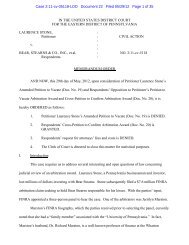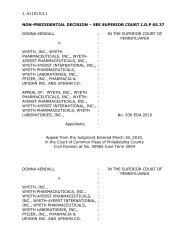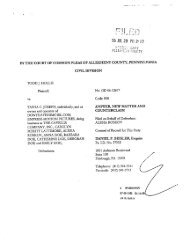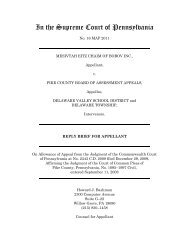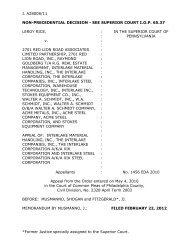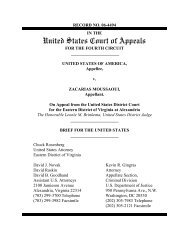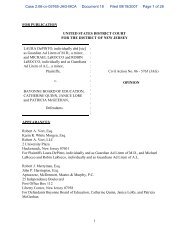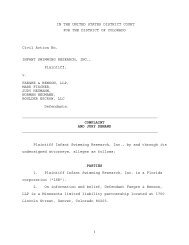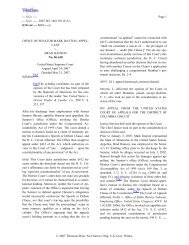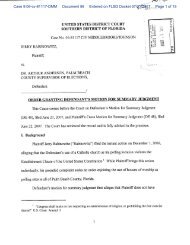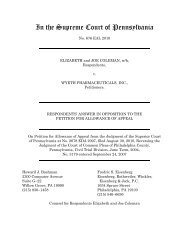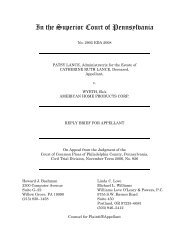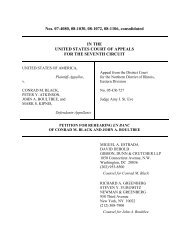the Brief in Opposition - How Appealing
the Brief in Opposition - How Appealing
the Brief in Opposition - How Appealing
You also want an ePaper? Increase the reach of your titles
YUMPU automatically turns print PDFs into web optimized ePapers that Google loves.
In The Supreme Court of Pennsylvania<br />
Nos. 869 & 870 MAL 2007<br />
LAURA A. AMBROGI, Co–Adm<strong>in</strong>istrator of <strong>the</strong> Estate of Tara DeSimone; and<br />
JAMES M. HOBAN, Co–Adm<strong>in</strong>istrator of <strong>the</strong> Estate of Tara DeSimone; and<br />
FRANK C. CIFELLI, Co–Adm<strong>in</strong>istrator of <strong>the</strong> Estate of Joseph DeSimone, a M<strong>in</strong>or;<br />
and JAMES M. HOBAN, Co–Adm<strong>in</strong>istrator of <strong>the</strong> Estate of Joseph DeSimone,<br />
a M<strong>in</strong>or,<br />
Pla<strong>in</strong>tiffs/Respondents,<br />
v.<br />
ROBERT M. REBER; and ROSEMARY REBER; and REBER REAL ESTATE, INC.;<br />
And REBER PROPERTY MANAGEMENT; et al.,<br />
Defendants/Petitioners.<br />
BRIEF IN OPPOSITION TO<br />
PETITION FOR ALLOWANCE OF APPEAL<br />
On Petition for Allowance of Appeal from <strong>the</strong> Judgment of <strong>the</strong> Superior Court of<br />
Pennsylvania at Nos. 1700 &1840 EDA 2006 filed September 7, 2007, Affirm<strong>in</strong>g <strong>the</strong><br />
Prelim<strong>in</strong>ary Injunction of <strong>the</strong> Court of Common Pleas of Delaware County,<br />
No. 05–2118 entered June 20, 2006<br />
<strong>How</strong>ard J. Bashman<br />
2300 Computer Avenue<br />
Suite G–22<br />
Willow Grove, PA 19090<br />
(215) 830–1458<br />
Counsel for Pla<strong>in</strong>tiffs/Respondents<br />
Larry Bendesky<br />
Brian E. Fritz<br />
Carmen P. Belefonte<br />
Saltz, Mongeluzzi, Barrett &<br />
Bendesky, P.C.<br />
1650 Market Street, 52nd Floor<br />
Philadelphia, PA 19103<br />
(215) 496–8282
TABLE OF CONTENTS<br />
Page<br />
I. INTRODUCTION ............................................................................................... 1<br />
II. RELEVANT FACTUAL AND PROCEDURAL HISTORY................................ 3<br />
III. REASONS WHY THE PETITION FOR ALLOWANCE OF APPEAL<br />
SHOULD BE DENIED ....................................................................................... 9<br />
A. Defendants’ Contention That The Superior Court Should Have<br />
Adopted Federal Law Or The Supposed Law Of Seven O<strong>the</strong>r<br />
States In Decid<strong>in</strong>g Whe<strong>the</strong>r To Affirm The Prohibitory<br />
Prelim<strong>in</strong>ary Injunction Is Without Merit And Has Been Waived.......... 9<br />
B. The Pennsylvania Superior Court’s Rul<strong>in</strong>g Rests On Well–<br />
Settled Pr<strong>in</strong>ciples Of Pennsylvania Law That Have Been<br />
Employed Rarely, Selectively, And Only In The Most<br />
Exceptional Cases .................................................................................. 15<br />
C. The F<strong>in</strong>al Basis For Allowance Of Appeal Asks This Court To<br />
Review And Correct Factual And Discretionary Determ<strong>in</strong>ations<br />
Made By The Trial Court And Thus Fails To Satisfy Any Of This<br />
Court’s Rigorous Standards For Review ............................................... 17<br />
IV. CONCLUSION.................................................................................................. 23
Cases<br />
TABLE OF AUTHORITIES<br />
Page<br />
Commonwealth v. Piper, 458 Pa. 307, 328 A.2d 845 (1974)....................................... 12<br />
Grupo Mexicano de Desarrollo, S.A. v. Alliance Bond Fund, Inc.,<br />
527 U.S. 308 (1999) ....................................................................... 2, 9–11, 13, 14<br />
Hoxworth v. Bl<strong>in</strong>der, Rob<strong>in</strong>son & Co., 903 F.2d 186 (3d Cir. 1990).......................... 13<br />
Pentlong Corp. v. GLS Capital, Inc., 573 Pa. 34, 820 A.2d 1240 (2003).................... 12<br />
Scratch Golf Co. v. Dunes West Residential Golf Properties, Inc.,<br />
603 S.E.2d 905 (S.C. 2004) ............................................................................... 14<br />
Walter v. Stacy, 837 A.2d 1205 (Pa. Super. Ct. 2003) ...................................... 7, 15, 16<br />
Statutes<br />
12 Pa. Cons. Stat. Ann. §§5101–5110 ......................................................................... 16<br />
12 Pa. Cons. Stat. Ann. §5101..................................................................................... 17<br />
12 Pa. Cons. Stat. Ann. §5104(a)(1) ............................................................................ 16<br />
12 Pa. Cons. Stat. Ann. §5107(a)(3)(i)......................................................................... 17<br />
Court Rules<br />
Pa. R. App. P. 302(a).................................................................................................... 12<br />
Pa. R. App. P. 1925(a).............................................................................................. 4, 18<br />
– ii –
I. INTRODUCTION<br />
On December 8, 2003, 23–year–old Tara DeSimone and her four–year–old<br />
son Joseph burned to death <strong>in</strong> a fire that occurred <strong>in</strong> <strong>the</strong> apartment where <strong>the</strong>y<br />
resided at 338 Beverly Boulevard <strong>in</strong> Upper Darby, Pennsylvania. The boy’s fa<strong>the</strong>r,<br />
Frank Cifelli, also lived <strong>in</strong> <strong>the</strong> apartment, and he suffered severe <strong>in</strong>juries <strong>in</strong> <strong>the</strong> fire<br />
but survived.<br />
In this lawsuit, <strong>the</strong> estates of Tara and Joseph DeSimone toge<strong>the</strong>r with<br />
Frank Cifelli have asserted that <strong>the</strong> owners of <strong>the</strong>ir apartment — defendants<br />
Robert and Rosemary Reber, ei<strong>the</strong>r <strong>in</strong>dividually or through Reber Real Estate, Inc.<br />
and/or Reber Property Management — are responsible <strong>in</strong> tort for hav<strong>in</strong>g caused <strong>the</strong><br />
deaths of Tara and Joseph DeSimone and <strong>the</strong> serious <strong>in</strong>juries susta<strong>in</strong>ed by Cifelli.<br />
The Reber defendants possess only $1 million <strong>in</strong> liability <strong>in</strong>surance applicable<br />
to <strong>the</strong> pla<strong>in</strong>tiffs’ claims. Between <strong>the</strong> time of <strong>the</strong> deadly fire and pla<strong>in</strong>tiffs’ motion<br />
for a prelim<strong>in</strong>ary <strong>in</strong>junction, <strong>the</strong> Reber defendants had sold off more than $3 million<br />
<strong>in</strong> real estate hold<strong>in</strong>gs, <strong>the</strong> proceeds of which were not re<strong>in</strong>vested back <strong>in</strong>to <strong>the</strong>ir<br />
real estate bus<strong>in</strong>ess enterprise. After conduct<strong>in</strong>g two evidentiary hear<strong>in</strong>gs and<br />
f<strong>in</strong>d<strong>in</strong>g that <strong>the</strong> Reber defendants appeared to be engaged <strong>in</strong> a process of render<strong>in</strong>g<br />
<strong>the</strong>mselves judgment–proof from execution on <strong>the</strong> excess judgment that appears<br />
certa<strong>in</strong> to result from pla<strong>in</strong>tiffs’ lawsuit, Judge Charles B. Burr, II of <strong>the</strong> Court of<br />
Common Pleas of Delaware County issued a limited and f<strong>in</strong>ely–calibrated<br />
prelim<strong>in</strong>ary <strong>in</strong>junction that merely requires <strong>the</strong> Reber defendants go<strong>in</strong>g forward to<br />
deposit <strong>the</strong> net proceeds realized on <strong>the</strong> sale of real estate properties <strong>in</strong>to a court–
monitored escrow account. The defendants are free to use or re<strong>in</strong>vest <strong>the</strong> money <strong>in</strong><br />
that escrow account on application to <strong>the</strong> trial court. The Superior Court’s<br />
affirmance of <strong>the</strong> trial court’s prelim<strong>in</strong>ary <strong>in</strong>junction absolutely does not preclude<br />
<strong>the</strong> defendants’ cont<strong>in</strong>ued use <strong>in</strong> <strong>the</strong> normal course of bus<strong>in</strong>ess of proceeds from<br />
sales of <strong>the</strong>ir real estate hold<strong>in</strong>gs.<br />
The prelim<strong>in</strong>ary <strong>in</strong>junction that <strong>the</strong> Reber defendants challenge by means of<br />
<strong>the</strong>ir Petition for Allowance of Appeal is based on well–settled Pennsylvania law,<br />
represents a proper exercise of <strong>the</strong> trial court’s discretion, and will <strong>in</strong> reality be<br />
mooted by <strong>the</strong> result of <strong>the</strong> jury trial scheduled to beg<strong>in</strong> <strong>in</strong> this case on March 17,<br />
2008. Moreover, <strong>the</strong> ma<strong>in</strong> argument advanced <strong>in</strong> <strong>the</strong> Petition for Allowance of<br />
Appeal — that <strong>the</strong> trial court’s <strong>in</strong>junction is contrary to <strong>in</strong>applicable federal law<br />
announced <strong>in</strong> <strong>the</strong> U.S. Supreme Court’s 5–4 rul<strong>in</strong>g <strong>in</strong> Grupo Mexicano de<br />
Desarrollo, S.A. v. Alliance Bond Fund, Inc., 527 U.S. 308 (1999) — is waived<br />
because <strong>the</strong> Reber defendants failed to cite to Grupo Mexicano <strong>in</strong> <strong>the</strong>ir Pa. Superior<br />
Court brief<strong>in</strong>g. Nor did <strong>the</strong> Reber defendants call <strong>the</strong> Grupo Mexicano decision to<br />
<strong>the</strong> Pa. Superior Court’s attention <strong>in</strong> any o<strong>the</strong>r manner, and <strong>the</strong> Reber defendants<br />
likewise never once cited to Grupo Mexicano while <strong>the</strong> pla<strong>in</strong>tiffs’ prelim<strong>in</strong>ary<br />
<strong>in</strong>junction request was pend<strong>in</strong>g before <strong>the</strong> trial court.<br />
For <strong>the</strong>se reasons, and <strong>the</strong> additional reasons detailed below, <strong>the</strong> Petition for<br />
Allowance of Appeal should be denied.<br />
– 2 –
II. RELEVANT FACTUAL AND PROCEDURAL HISTORY<br />
The lawsuit that gives rise to this matter asserts that <strong>the</strong> Reber defendants<br />
are liable <strong>in</strong> tort for hav<strong>in</strong>g caused <strong>the</strong> deaths of 23–year–old Tara DeSimone and<br />
her four–year–old son Joseph, both of whom burned to death <strong>in</strong> a fire that occurred<br />
<strong>in</strong> an apartment owned and ma<strong>in</strong>ta<strong>in</strong>ed by <strong>the</strong> Reber defendants. The lawsuit also<br />
asserts that <strong>the</strong> Reber defendants are liable <strong>in</strong> tort for hav<strong>in</strong>g caused pla<strong>in</strong>tiff<br />
Frank Cifelli, who was Joseph’s fa<strong>the</strong>r and Tara’s companion, to susta<strong>in</strong> serious<br />
<strong>in</strong>juries <strong>in</strong> that very same fire. The fire occurred on December 8, 2003 at 338<br />
Beverly Boulevard <strong>in</strong> Upper Darby, Pennsylvania.<br />
In May 2006, <strong>the</strong> Reber defendants notified counsel for <strong>the</strong> pla<strong>in</strong>tiffs that <strong>the</strong><br />
338 Beverly Boulevard property was under contract to be sold to an unrelated<br />
third–party. Shortly <strong>the</strong>reafter, <strong>the</strong> pla<strong>in</strong>tiffs discovered that <strong>the</strong> Reber defendants<br />
had, between <strong>the</strong> time of <strong>the</strong> fire <strong>in</strong> December 2003 and May 2006, sold off more<br />
than $3 million <strong>in</strong> real estate hold<strong>in</strong>gs without re<strong>in</strong>vest<strong>in</strong>g any of <strong>the</strong> proceeds of<br />
those sales back <strong>in</strong>to <strong>the</strong>ir real estate bus<strong>in</strong>ess.<br />
It is undisputed that <strong>the</strong> Reber defendants possess only $1 million <strong>in</strong> liability<br />
<strong>in</strong>surance applicable to pla<strong>in</strong>tiffs’ claims — that defendants are liable <strong>in</strong> tort for<br />
caus<strong>in</strong>g <strong>the</strong> death of a young mo<strong>the</strong>r and her small child and caus<strong>in</strong>g serious<br />
personal <strong>in</strong>juries to a third person, stemm<strong>in</strong>g from a fire alleged to have resulted<br />
from defendants’ negligence. It is also undisputed that <strong>the</strong> value of pla<strong>in</strong>tiffs’ claims<br />
aga<strong>in</strong>st <strong>the</strong> Reber defendants is substantially <strong>in</strong> excess of $1 million.<br />
– 3 –
Believ<strong>in</strong>g that <strong>the</strong> Reber defendants were engaged <strong>in</strong> an ongo<strong>in</strong>g scheme<br />
<strong>in</strong>tended to divest <strong>the</strong>mselves of assets to make <strong>the</strong>mselves execution–proof <strong>in</strong> <strong>the</strong><br />
event of a verdict <strong>in</strong> favor of <strong>the</strong> pla<strong>in</strong>tiffs <strong>in</strong> excess of <strong>the</strong> $1 million <strong>in</strong>surance<br />
coverage applicable to <strong>the</strong> deadly fire, pla<strong>in</strong>tiffs moved for a prelim<strong>in</strong>ary <strong>in</strong>junction<br />
to require only that <strong>the</strong> Reber defendants place <strong>in</strong>to a court–supervised escrow<br />
account <strong>the</strong> net proceeds of any sale of real property, which could <strong>the</strong>n be re<strong>in</strong>vested<br />
by <strong>the</strong> Reber defendants at any time with approval of <strong>the</strong> trial court.<br />
After two separate lengthy hear<strong>in</strong>gs, <strong>the</strong> Court of Common Pleas of Delaware<br />
County issued a limited and f<strong>in</strong>ely–calibrated prelim<strong>in</strong>ary <strong>in</strong>junction that merely<br />
requires <strong>the</strong> defendant to deposit <strong>in</strong>to a court–supervised escrow account <strong>the</strong> net<br />
proceeds of future real estate sales, which may be used or o<strong>the</strong>rwise re<strong>in</strong>vested on<br />
application to <strong>the</strong> trial court.<br />
As Judge Burr expla<strong>in</strong>s <strong>in</strong> his Rule 1925(a) op<strong>in</strong>ion:<br />
Trial court op<strong>in</strong>ion at 19.<br />
states:<br />
The amount of a potential verdict aga<strong>in</strong>st <strong>the</strong> Defendants <strong>in</strong> <strong>the</strong> case at<br />
bar cannot be presently ascerta<strong>in</strong>ed, and given <strong>the</strong> horrific deaths and<br />
<strong>in</strong>juries from <strong>the</strong> fire that gave rise to this law suit, <strong>the</strong> damages<br />
awarded, if Pla<strong>in</strong>tiffs prevail, could be large <strong>in</strong>deed. To allow <strong>the</strong><br />
Defendants <strong>the</strong> ability to spend <strong>the</strong> proceeds of liquidation of <strong>the</strong>ir<br />
assets at will under <strong>the</strong> circumstances before <strong>the</strong> Court will thus work<br />
an irreparable harm to <strong>the</strong> pla<strong>in</strong>tiffs’ ability to recover <strong>the</strong> full<br />
measure of <strong>the</strong> damages <strong>in</strong>curred.<br />
In sett<strong>in</strong>g forth <strong>the</strong> basis for <strong>the</strong> prelim<strong>in</strong>ary <strong>in</strong>junction, Judge Burr’s op<strong>in</strong>ion<br />
Although Defendants have realized close to $3,000,000.00 from this<br />
apparent fire sale of <strong>the</strong>ir property s<strong>in</strong>ce December of 2003, <strong>the</strong>re is no<br />
evidence that <strong>the</strong>y are still <strong>in</strong> possession of <strong>the</strong>se funds or whe<strong>the</strong>r, as<br />
– 4 –
Id. at 17<br />
defense counsel have occasionally and jok<strong>in</strong>gly suggested, <strong>the</strong>y were<br />
used to buy a boat or were given to o<strong>the</strong>rs, or are sitt<strong>in</strong>g <strong>in</strong> a bank <strong>in</strong><br />
<strong>the</strong> Cayman Islands. All <strong>in</strong> all, <strong>the</strong> rapid rate of <strong>the</strong> tim<strong>in</strong>g and <strong>the</strong><br />
large amount of proceeds realized from Defendants’ sale of <strong>the</strong>ir assets<br />
s<strong>in</strong>ce <strong>the</strong> time of <strong>the</strong> fire, coupled with <strong>the</strong> potential for a verdict larger<br />
than <strong>the</strong> available <strong>in</strong>surance coverage, as well as <strong>the</strong> case authority of<br />
Walter v. Stacy, supra, which is relevant to just such circumstances as<br />
are presented here below, provide a reasonable basis for entry of <strong>the</strong><br />
unobtrusive and well–tailored Order which is <strong>the</strong> subject of this<br />
appeal.<br />
In a critical passage that <strong>the</strong> Petition for Allowance of Appeal essentially<br />
overlooks, Judge Burr’s op<strong>in</strong>ion <strong>the</strong>n proceeds to expla<strong>in</strong>:<br />
Id.<br />
Fur<strong>the</strong>r, this Order does not preclude nor impede <strong>the</strong> Defendants from<br />
enter<strong>in</strong>g <strong>in</strong>to any real estate purchase or sale, nor does it cloud title to<br />
any of <strong>the</strong> properties that might be <strong>in</strong>volved, nor encumber any sale as<br />
claimed. The Order merely requires <strong>the</strong> Defendants to advise <strong>the</strong> Court<br />
of any sale or transfer of any real property <strong>in</strong> which <strong>the</strong>y possess an<br />
ownership <strong>in</strong>terest, to place <strong>the</strong> net proceeds <strong>the</strong>reof <strong>in</strong> an <strong>in</strong>terest<br />
bear<strong>in</strong>g account <strong>in</strong> accord with Defendants’ own suggestion, and to<br />
petition <strong>the</strong> Court for permission to make withdrawals <strong>the</strong>refrom.<br />
In <strong>the</strong> nearly one and a half years s<strong>in</strong>ce <strong>the</strong> trial court entered that<br />
prelim<strong>in</strong>ary <strong>in</strong>junction, <strong>the</strong> trial court has not once prevented <strong>the</strong> Reber defendants<br />
from re<strong>in</strong>vest<strong>in</strong>g <strong>the</strong> proceeds of sales of real estate back <strong>in</strong>to <strong>the</strong>ir real estate<br />
bus<strong>in</strong>ess. Quite simply, <strong>the</strong> prelim<strong>in</strong>ary <strong>in</strong>junction only prevents <strong>the</strong> Reber<br />
defendants from abscond<strong>in</strong>g away with <strong>the</strong> assets of <strong>the</strong>ir bus<strong>in</strong>ess enterprises so as<br />
to make <strong>the</strong>mselves judgment–proof <strong>in</strong> <strong>the</strong> event of a judgment <strong>in</strong> excess of one<br />
million dollars.<br />
– 5 –
The Reber defendants <strong>the</strong>reafter appealed from <strong>the</strong> entry of <strong>the</strong> prelim<strong>in</strong>ary<br />
<strong>in</strong>junction to <strong>the</strong> Superior Court of Pennsylvania. On appeal, <strong>the</strong> Reber defendants<br />
did not argue — as <strong>the</strong>y now ma<strong>in</strong>ta<strong>in</strong> as <strong>the</strong> central basis of <strong>the</strong>ir Petition for<br />
Allowance of Appeal — that a prelim<strong>in</strong>ary <strong>in</strong>junction entered to preserve a<br />
defendant’s assets where <strong>the</strong> evidence strongly suggests <strong>the</strong> pursuit of a scheme to<br />
become judgment–proof is never lawfully permitted. Ra<strong>the</strong>r, <strong>in</strong> <strong>the</strong> Superior Court,<br />
<strong>the</strong> Reber defendants had only argued that <strong>the</strong> trial court abused its discretion by<br />
supposedly misweigh<strong>in</strong>g <strong>the</strong> handful of factors pert<strong>in</strong>ent to <strong>the</strong> grant of a<br />
prelim<strong>in</strong>ary <strong>in</strong>junction.<br />
On April 10, 2007, <strong>the</strong>re was oral argument <strong>in</strong> this appeal before a panel<br />
consist<strong>in</strong>g of three of <strong>the</strong> Pa. Superior Court’s most experienced jurists: Joseph A.<br />
Hudock, Maureen Lally–Green, and Robert E. Colville. On July 24, 2007, that<br />
three–judge panel issued a non–precedential Memorandum Op<strong>in</strong>ion affirm<strong>in</strong>g <strong>the</strong><br />
trial court’s prelim<strong>in</strong>ary <strong>in</strong>junction. The use of a non–precedential Memorandum<br />
Op<strong>in</strong>ion reflected <strong>the</strong> Superior Court panel’s considered judgment that its rul<strong>in</strong>g<br />
consisted of an uncontroversial application of well–settled exist<strong>in</strong>g law.<br />
On petition of <strong>the</strong> pla<strong>in</strong>tiffs, which <strong>the</strong> Reber defendants opposed, <strong>the</strong><br />
Superior Court panel decided to withdraw <strong>the</strong> Memorandum Op<strong>in</strong>ion and reissue<br />
<strong>the</strong> identical decision as a published op<strong>in</strong>ion <strong>in</strong> which Judge Hudock was identified<br />
as <strong>the</strong> author. It is from that decision that <strong>the</strong> Reber defendants have filed <strong>the</strong>ir<br />
Petition for Allowance of Appeal.<br />
– 6 –
Judge Hudock’s op<strong>in</strong>ion for <strong>the</strong> Superior Court expla<strong>in</strong>s that “[t]he entry of a<br />
prelim<strong>in</strong>ary <strong>in</strong>junction for <strong>the</strong> purpose of enjo<strong>in</strong><strong>in</strong>g <strong>the</strong> dissipation of assets <strong>in</strong><br />
anticipation of a lawsuit is not a novel event.” Slip Op. at 8. Rely<strong>in</strong>g primarily on<br />
<strong>the</strong> Pa. Superior Court’s 2003 precedent <strong>in</strong> Walter v. Stacy, 837 A.2d 1205 (Pa.<br />
Super. Ct. 2003), Judge Hudock’s op<strong>in</strong>ion expla<strong>in</strong>s: “There is noth<strong>in</strong>g unique about<br />
<strong>the</strong> requirement imposed by <strong>the</strong> trial court <strong>in</strong> this case that precludes Appellants<br />
from sell<strong>in</strong>g <strong>the</strong>ir real property without plac<strong>in</strong>g <strong>the</strong> net proceeds <strong>in</strong>to a court<br />
supervised escrow account. * * * We conclude that Pennsylvania law does not<br />
preclude a trial court from grant<strong>in</strong>g a prelim<strong>in</strong>ary <strong>in</strong>junction to prevent dissipation<br />
of assets.” Slip Op. at 9.<br />
Judge Hudock’s op<strong>in</strong>ion conta<strong>in</strong>s <strong>the</strong> follow<strong>in</strong>g summary of <strong>the</strong> trial court’s<br />
f<strong>in</strong>d<strong>in</strong>gs <strong>in</strong> support of <strong>the</strong> prelim<strong>in</strong>ary <strong>in</strong>junction:<br />
Slip Op. at 12.<br />
The trial court has expla<strong>in</strong>ed <strong>in</strong> great detail why it concluded<br />
that an <strong>in</strong>junction was necessary to prevent immediate and irreparable<br />
harm to Appellees that cannot o<strong>the</strong>rwise be compensated adequately.<br />
The trial court found <strong>the</strong> likelihood to be “undeniably strong” that a<br />
jury will return a verdict well <strong>in</strong> excess of a million dollars <strong>in</strong> this case.<br />
Trial Court Op<strong>in</strong>ion, 11/9/06, at 16. <strong>How</strong>ever, <strong>the</strong> record discloses that<br />
Appellants have only a million dollars <strong>in</strong> liability <strong>in</strong>surance applicable<br />
to <strong>the</strong> fire that caused <strong>the</strong> deaths by burn<strong>in</strong>g of a young mo<strong>the</strong>r and<br />
her child and <strong>the</strong> serious <strong>in</strong>jury of a third <strong>in</strong>dividual. Id. Appellants do<br />
possess extensive real estate hold<strong>in</strong>gs <strong>in</strong> Pennsylvania, which <strong>the</strong> trial<br />
court found would be more than adequate to satisfy any verdict<br />
Appellees are likely to obta<strong>in</strong> aga<strong>in</strong>st Appellants—but only if<br />
Appellants rema<strong>in</strong> <strong>in</strong> possession of <strong>the</strong>se assets at <strong>the</strong> time a judgment<br />
is entered. Id. at 16–17.<br />
– 7 –
In affirm<strong>in</strong>g <strong>the</strong> prelim<strong>in</strong>ary <strong>in</strong>junction at issue, <strong>the</strong> Superior Court took care<br />
to emphasize <strong>the</strong> prelim<strong>in</strong>ary <strong>in</strong>junction’s limited and f<strong>in</strong>ely–calibrated effect,<br />
which <strong>the</strong> Reber defendants ignore <strong>in</strong> <strong>the</strong>ir Petition for Allowance of Appeal:<br />
Appellants have not been precluded from list<strong>in</strong>g and sell<strong>in</strong>g<br />
<strong>the</strong>ir properties, from re<strong>in</strong>vest<strong>in</strong>g <strong>the</strong> net proceeds from any sales or<br />
from us<strong>in</strong>g <strong>the</strong> net proceeds <strong>in</strong> a manner consistent with <strong>the</strong>ir normal<br />
bus<strong>in</strong>ess practices. The trial court’s <strong>in</strong>junction simply prevents<br />
Appellants from liquidat<strong>in</strong>g <strong>the</strong>ir properties for <strong>the</strong> purpose of hid<strong>in</strong>g<br />
or dissipat<strong>in</strong>g assets. As already discussed, Appellees have been<br />
required to post a bond sufficient to cover any loss of <strong>in</strong>terest<br />
Appellants might experience by be<strong>in</strong>g required to escrow funds. We<br />
aga<strong>in</strong> note that <strong>the</strong> trial court clearly <strong>in</strong>dicated it would establish a<br />
reasonable ceil<strong>in</strong>g to <strong>the</strong> amount held <strong>in</strong> escrow and that Appellants<br />
are free to petition at any time for <strong>the</strong> release of funds so that <strong>the</strong>ir<br />
assets can be used to run <strong>the</strong>ir bus<strong>in</strong>ess and are not irrationally tied–<br />
up.<br />
Id. at 18–19 (citations omitted).<br />
As Judge Hudock’s op<strong>in</strong>ion recognizes, “Appellants have not cited to any<br />
authority, ei<strong>the</strong>r statutory or decisional, that affords <strong>the</strong>m a legal right to dissipate<br />
assets for <strong>the</strong> purpose of becom<strong>in</strong>g judgment–proof. This is <strong>the</strong> conduct that <strong>the</strong><br />
trial court’s <strong>in</strong>junction prohibits, not <strong>the</strong> lawful conduct of runn<strong>in</strong>g <strong>the</strong>ir bus<strong>in</strong>ess.”<br />
Slip Op. at 19.<br />
Judge Hudock, writ<strong>in</strong>g on behalf of a unanimous three–judge Pa. Superior<br />
Court panel, is absolutely correct. The Reber defendants’ Petition for Allowance of<br />
Appeal brazenly asks this Court to grant allocatur to hold that Pennsylvania law<br />
would permit defendants whose negligence has caused a young mo<strong>the</strong>r and her<br />
four–year–old child to burn to death and <strong>the</strong> child’s fa<strong>the</strong>r to suffer severe <strong>in</strong>juries<br />
– 8 –
<strong>in</strong> that same fire to systematically render <strong>the</strong>mselves judgment–proof <strong>in</strong> order to<br />
avoid f<strong>in</strong>ancial responsibility for <strong>the</strong>ir tortious misconduct.<br />
Such an outrageous request should not be granted by this Honorable Court.<br />
Fortunately, <strong>the</strong> Petition for Allowance of Appeal fails to establish that any of <strong>the</strong><br />
three <strong>the</strong> questions presented <strong>the</strong>re<strong>in</strong> are worthy of this Court’s review, and<br />
<strong>the</strong>refore <strong>the</strong> Petition for Allowance of Appeal should be denied.<br />
III. REASONS WHY THE PETITION FOR ALLOWANCE OF APPEAL<br />
SHOULD BE DENIED<br />
A. Defendants’ Contention That The Superior Court Should Have<br />
Adopted Federal Law Or The Supposed Law Of Seven O<strong>the</strong>r<br />
States In Decid<strong>in</strong>g Whe<strong>the</strong>r To Affirm The Prohibitory<br />
Prelim<strong>in</strong>ary Injunction Is Without Merit And Has Been Waived<br />
This case <strong>in</strong>volves absolutely no federal question whatsoever that might<br />
arguably cause <strong>the</strong> U.S. Supreme Court rul<strong>in</strong>g on which <strong>the</strong> Petition for Allowance<br />
of Appeal relies so heavily to be relevant to this case.<br />
Due to a unique quirk of federal law, <strong>the</strong> equitable power of U.S. District<br />
Courts is limited to <strong>the</strong> power that chancery courts possessed <strong>in</strong> England <strong>in</strong> <strong>the</strong><br />
year 1789. Thus, <strong>the</strong> question confront<strong>in</strong>g <strong>the</strong> U.S. Supreme Court <strong>in</strong> Grupo<br />
Mexicano de Desarrollo, S.A. v. Alliance Bond Fund, Inc., 527 U.S. 308 (1999), was<br />
whe<strong>the</strong>r a prelim<strong>in</strong>ary <strong>in</strong>junction could be used to restra<strong>in</strong> a defendant’s assets to<br />
protect a potential money judgment <strong>in</strong> favor of <strong>the</strong> pla<strong>in</strong>tiff under federal common<br />
law applicable only <strong>in</strong> <strong>the</strong> federal court system.<br />
– 9 –
Recogniz<strong>in</strong>g that Congress could legislate such a remedy, <strong>the</strong> majority <strong>in</strong> <strong>the</strong><br />
U.S. Supreme Court’s 5–4 rul<strong>in</strong>g <strong>in</strong> Grupo Mexicano held that because <strong>the</strong> chancery<br />
courts of England did not recognize <strong>the</strong> propriety of such an <strong>in</strong>junction <strong>in</strong> 1789,<br />
federal district courts lacked <strong>the</strong> power under federal common law to issue such an<br />
<strong>in</strong>junction today. Both <strong>the</strong> majority and dissent <strong>in</strong> <strong>the</strong> Grupo Mexicano case<br />
recognized that <strong>in</strong> 1975, England’s chancery courts issued a rul<strong>in</strong>g that recognized<br />
as proper and lawful <strong>the</strong> use of a prelim<strong>in</strong>ary <strong>in</strong>junction to restra<strong>in</strong> a defendant’s<br />
assets to protect a potential money judgment <strong>in</strong> favor of <strong>the</strong> pla<strong>in</strong>tiff. See Grupo<br />
Mexicano, 527 U.S. at 327 (not<strong>in</strong>g that <strong>the</strong> English Court of Chancery “did not<br />
provide an <strong>in</strong>junctive remedy such as this until 1975”); id. at 339 (G<strong>in</strong>sburg, J.,<br />
dissent<strong>in</strong>g) (“As <strong>the</strong> Court observes, prelim<strong>in</strong>ary asset–freeze <strong>in</strong>junctions have been<br />
available <strong>in</strong> English courts s<strong>in</strong>ce * * * 1975”). But because English equitable courts<br />
had not recognized <strong>the</strong> remedy <strong>in</strong> 1789, <strong>the</strong> majority <strong>in</strong> Grupo Mexicano, by a<br />
sharply divided 5–4 vote, ruled that later developments <strong>in</strong> <strong>the</strong> equitable law of<br />
England were irrelevant to <strong>the</strong> equitable authority of federal district courts <strong>in</strong> <strong>the</strong><br />
United States. It bears observation that two members of <strong>the</strong> slender five Justice<br />
majority <strong>in</strong> Grupo Mexicano — Chief Justice William H. Rehnquist and Associate<br />
Justice Sandra Day O’Connor — have s<strong>in</strong>ce left <strong>the</strong> Court.<br />
The Petition for Allowance of Appeal relies on <strong>the</strong> U.S. Supreme Court’s 1999<br />
rul<strong>in</strong>g <strong>in</strong> Grupo Mexicano and <strong>the</strong> decisions of <strong>the</strong> courts of seven o<strong>the</strong>r states (five<br />
of which were not issued by state courts of last resort) to assert that somehow <strong>the</strong><br />
Superior Court of Pennsylvania’s rul<strong>in</strong>g, which followed well–settled Pennsylvania<br />
– 10 –
law to prevent <strong>the</strong> Reber defendants from cont<strong>in</strong>u<strong>in</strong>g with <strong>the</strong>ir scheme to strip<br />
<strong>the</strong>mselves of all assets and thus become judgment–proof, is deserv<strong>in</strong>g of this<br />
Court’s review.<br />
This first ground for review advanced <strong>in</strong> <strong>the</strong> Reber defendants’ Petition for<br />
Allowance of Appeal must be rejected for two <strong>in</strong>dependent reasons: first, this<br />
ground for review has been waived, because <strong>the</strong> Reber defendants never once raised<br />
or relied on Grupo Mexicano or <strong>the</strong> o<strong>the</strong>r state court rul<strong>in</strong>gs <strong>in</strong> <strong>the</strong>ir appellate<br />
brief<strong>in</strong>g before <strong>the</strong> Pa. Superior Court; and second, <strong>the</strong> fact that seven state courts<br />
(<strong>in</strong> decisions whose authority is open to substantial question, as discussed below)<br />
have followed <strong>the</strong> U.S. Supreme Court’s antiquated view of equitable power does not<br />
make that outdated approach <strong>the</strong> “majority approach” or an approach that<br />
Pennsylvania courts should choose to follow.<br />
On <strong>the</strong> issue of waiver, <strong>the</strong> Reber defendants’ <strong>Brief</strong> for Appellants filed <strong>in</strong> <strong>the</strong><br />
Pa. Superior Court failed to cite even once to <strong>the</strong> U.S. Supreme Court’s rul<strong>in</strong>g <strong>in</strong><br />
Grupo Mexicano, and <strong>the</strong> <strong>Brief</strong> for Appellants never asserted that it was beyond a<br />
Pennsylvania court’s equitable authority to issue a prelim<strong>in</strong>ary <strong>in</strong>junction to<br />
restra<strong>in</strong> a defendant’s assets to protect a potential money judgment <strong>in</strong> favor of <strong>the</strong><br />
pla<strong>in</strong>tiff. The Reber defendants also failed to draw <strong>the</strong> Grupo Mexicano decision to<br />
<strong>the</strong> Pa. Superior Court’s attention <strong>in</strong> any o<strong>the</strong>r way and did not once mention <strong>the</strong><br />
rul<strong>in</strong>g at oral argument. Moreover, nei<strong>the</strong>r with<strong>in</strong> <strong>the</strong>ir brief nor at oral argument<br />
did <strong>the</strong> Reber defendants cite any of <strong>the</strong> o<strong>the</strong>r seven state court rul<strong>in</strong>gs that<br />
supposedly represent a “majority” view.<br />
– 11 –
Defendants ma<strong>in</strong>ta<strong>in</strong> <strong>in</strong> <strong>the</strong>ir Petition for Allowance of Appeal that <strong>the</strong> Pa.<br />
Superior Court’s earlier precedents did not compel a rul<strong>in</strong>g <strong>in</strong> favor of <strong>the</strong> pla<strong>in</strong>tiffs<br />
on appeal, but <strong>the</strong> defendants failed to present to <strong>the</strong> Superior Court any of <strong>the</strong> case<br />
law from o<strong>the</strong>r jurisdictions that defendants now contend <strong>the</strong> Superior Court erred<br />
<strong>in</strong> fail<strong>in</strong>g to follow. The defendants’ failure to draw that case law to <strong>the</strong> attention of<br />
<strong>the</strong> Superior Court gives rise to a classic <strong>in</strong>stance of waiver that mandates denial of<br />
<strong>the</strong> first question presented for review. See Pa. R. App. P. 302(a); Pentlong Corp. v.<br />
GLS Capital, Inc., 573 Pa. 34, 48 n.17, 820 A.2d 1240, 1248 n.17 (2003) (hold<strong>in</strong>g<br />
that argument not presented to <strong>in</strong>termediate appellate court is waived and will not<br />
be considered by this Court); Commonwealth v. Piper, 458 Pa. 307, 309–11, 328<br />
A.2d 845, 847 (1974) (issue not raised <strong>in</strong> trial court or Superior Court cannot be<br />
raised for first time on allocatur).<br />
Fur<strong>the</strong>rmore, <strong>the</strong> strength of authority that those seven state court rul<strong>in</strong>gs<br />
represent is vastly overstated <strong>in</strong> <strong>the</strong> Petition for Allowance of Appeal. Only two of<br />
those seven decisions come from state courts of last resort. Four of those seven<br />
decisions come from state <strong>in</strong>termediate appellate courts, two of those four are<br />
<strong>in</strong>termediate appellate courts lack<strong>in</strong>g statewide jurisdiction, and one of those four<br />
decisions is an unpublished, non–precedential <strong>in</strong>termediate appellate court rul<strong>in</strong>g.<br />
The f<strong>in</strong>al one of those seven state court rul<strong>in</strong>gs is a trial court’s op<strong>in</strong>ion. In short,<br />
defendants’ claim that those seven state court decisions represent a majority view is<br />
refuted by <strong>the</strong> very tenuous authority offered <strong>in</strong> support of that unconv<strong>in</strong>c<strong>in</strong>g claim.<br />
– 12 –
The Reber defendants’ Petition for Allowance of Appeal attempts to mislead<br />
this Court <strong>in</strong>to believ<strong>in</strong>g that perhaps <strong>the</strong> Reber defendants had presented this very<br />
same argument to <strong>the</strong> Pa. Superior Court, because <strong>the</strong> Petition for Allowance of<br />
Appeal chides <strong>the</strong> Superior Court for “ignor<strong>in</strong>g <strong>the</strong> substantial authority” consist<strong>in</strong>g<br />
of Grupo Mexicano and <strong>the</strong> aforementioned seven state court rul<strong>in</strong>gs. Pet. at 15. Yet<br />
it is <strong>the</strong> Reber defendants, and not <strong>the</strong> Pa. Superior Court, who must be faulted,<br />
because <strong>the</strong> Reber defendants did not cite to any of that case law when brief<strong>in</strong>g or<br />
argu<strong>in</strong>g this appeal before <strong>the</strong> Superior Court. The “substantial authority” that <strong>the</strong><br />
Reber defendants now condemn <strong>the</strong> Pa. Superior Court for “ignor<strong>in</strong>g” (Pet. at 15) is<br />
<strong>the</strong> very same “substantial authority” that <strong>the</strong> Reber defendants <strong>the</strong>mselves ignored<br />
<strong>in</strong> <strong>the</strong>ir <strong>Brief</strong> for Appellants filed <strong>in</strong> <strong>the</strong> Pa. Superior Court.<br />
To summarize, <strong>the</strong> Reber defendants’ argument before <strong>the</strong> Pa. Superior Court<br />
was never that a court of equity <strong>in</strong> Pennsylvania lacks <strong>the</strong> <strong>in</strong>herent power to issue<br />
<strong>the</strong> sort of prelim<strong>in</strong>ary <strong>in</strong>junction at issue here, and <strong>the</strong> only federal case that <strong>the</strong>y<br />
cited on that po<strong>in</strong>t recognized that even a federal court could issue such an<br />
<strong>in</strong>junction under appropriate circumstances, see Hoxworth v. Bl<strong>in</strong>der, Rob<strong>in</strong>son &<br />
Co., 903 F.2d 186, 198 (3d Cir. 1990) (Becker, J.). Even if <strong>the</strong> Pa. Superior Court’s<br />
rul<strong>in</strong>g aga<strong>in</strong>st <strong>the</strong> Reber defendants were erroneous, which it is not, it would consist<br />
of <strong>in</strong>vited error that <strong>the</strong> Reber defendants brought upon <strong>the</strong>mselves. Because <strong>the</strong><br />
first issue is waived, it provides no basis for grant<strong>in</strong>g allowance of appeal.<br />
Moreover, even if <strong>the</strong> Reber defendants’ argument based on Grupo Mexicano<br />
were not waived, it would still be without merit. The Supreme Court of South<br />
– 13 –
Carol<strong>in</strong>a, <strong>in</strong> 2004, was faced with <strong>the</strong> very same argument based on Grupo<br />
Mexicano that <strong>the</strong> Reber defendants are now belatedly seek<strong>in</strong>g to make before this<br />
Court. See Scratch Golf Co. v. Dunes West Residential Golf Properties, Inc., 603<br />
S.E.2d 905 (S.C. 2004). South Carol<strong>in</strong>a’s highest court correctly rejected <strong>the</strong><br />
argument, recogniz<strong>in</strong>g that Grupo Mexicano merely held “that a U.S. District Court<br />
was not authorized to issue a prelim<strong>in</strong>ary <strong>in</strong>junction — absent a prior attachment of<br />
a money judgment — because <strong>the</strong> remedy was historically unavailable <strong>in</strong> a federal<br />
court of equity.” Scratch Golf Co., 603 S.E.2d at 907.<br />
Directly address<strong>in</strong>g <strong>the</strong> U.S. Supreme Court’s rul<strong>in</strong>g <strong>in</strong> Grupo Mexicano,<br />
South Carol<strong>in</strong>a’s highest court unanimously held:<br />
This decision limit<strong>in</strong>g a federal court’s equitable powers is not<br />
dispositive of whe<strong>the</strong>r a state court judge may restra<strong>in</strong> a defendant’s<br />
assets prior to <strong>the</strong> attachment of a money judgment. There is no<br />
federal question here that would cause <strong>the</strong> Grupo decision to be<br />
b<strong>in</strong>d<strong>in</strong>g <strong>in</strong> this state court proceed<strong>in</strong>g. Thus we decl<strong>in</strong>e to apply <strong>the</strong><br />
Grupo analysis to this matter.<br />
Scratch Golf Co., 603 S.E.2d at 907.<br />
The first ground on which <strong>the</strong> Reber defendants seek allowance of appeal —<br />
based on Grupo Mexicano and <strong>the</strong> rul<strong>in</strong>g of a handful of courts from o<strong>the</strong>r states —<br />
is both without merit and waived and <strong>the</strong>refore should be rejected.<br />
– 14 –
B. The Pennsylvania Superior Court’s Rul<strong>in</strong>g Rests On Well–<br />
Settled Pr<strong>in</strong>ciples Of Pennsylvania Law That Have Been<br />
Employed Rarely, Selectively, And Only In The Most<br />
Exceptional Cases<br />
The decision <strong>the</strong> Pa. Superior Court issued <strong>in</strong> this case — orig<strong>in</strong>ally as a non–<br />
precedential Memorandum Op<strong>in</strong>ion — relied heavily on <strong>the</strong> Pa. Superior Court’s<br />
December 1, 2003 rul<strong>in</strong>g <strong>in</strong> Walter v. Stacy, 837 A.2d 1205 (Pa. Super. Ct. 2003),<br />
which affirmed a prelim<strong>in</strong>ary <strong>in</strong>junction that prevented two defendants who had<br />
been sued for caus<strong>in</strong>g <strong>the</strong> death of ano<strong>the</strong>r person from engag<strong>in</strong>g <strong>in</strong> <strong>the</strong> “unfair,<br />
wholesale dissolution of <strong>the</strong>ir assets <strong>in</strong> anticipation of civil liability.” Id. at 1207.<br />
It would <strong>in</strong>deed be a frighten<strong>in</strong>g proposition if anytime that someone<br />
commenced a civil suit for damages <strong>the</strong> pla<strong>in</strong>tiff could obta<strong>in</strong> a prelim<strong>in</strong>ary<br />
<strong>in</strong>junction requir<strong>in</strong>g <strong>the</strong> defendant to ma<strong>in</strong>ta<strong>in</strong> a court–supervised escrow account<br />
conta<strong>in</strong><strong>in</strong>g sufficient funds to pay <strong>the</strong> pla<strong>in</strong>tiff’s claim. But while <strong>the</strong> Reber<br />
defendants predict that <strong>the</strong> rul<strong>in</strong>g aga<strong>in</strong>st <strong>the</strong>m will give rise to just that parade of<br />
horribles, <strong>the</strong> empirical evidence demonstrates that noth<strong>in</strong>g could be fur<strong>the</strong>r from<br />
<strong>the</strong> truth.<br />
The calumny and disda<strong>in</strong> that <strong>the</strong> Reber defendants direct toward <strong>the</strong> Pa.<br />
Superior Court’s rul<strong>in</strong>g <strong>in</strong> <strong>the</strong>ir case and <strong>in</strong> <strong>the</strong> Walter case draw no support from<br />
what is actually happen<strong>in</strong>g <strong>in</strong> <strong>the</strong> real world. S<strong>in</strong>ce December 1, 2003, <strong>the</strong>re has<br />
been no rash of successful prelim<strong>in</strong>ary <strong>in</strong>junction motions to restra<strong>in</strong> <strong>the</strong> assets of<br />
defendants who are suspected of seek<strong>in</strong>g to become judgment–proof, and <strong>the</strong>re is no<br />
reason to believe that <strong>the</strong> Pa. Superior Court’s recent rul<strong>in</strong>g <strong>in</strong> this case will give<br />
– 15 –
ise to an abundance of such motions when <strong>the</strong> Walter case, now nearly four years<br />
old, has failed to do so.<br />
What <strong>the</strong> Reber defendants are <strong>in</strong> fact ask<strong>in</strong>g this Court to hold, as <strong>the</strong> Pa.<br />
Superior Court’s rul<strong>in</strong>g correctly recognized, is that <strong>the</strong>y have “a legal right to<br />
dissipate assets for <strong>the</strong> purpose of becom<strong>in</strong>g judgment–proof.” Slip Op. at 19. The<br />
trial court’s limited, f<strong>in</strong>ely–calibrated prelim<strong>in</strong>ary <strong>in</strong>junction allows <strong>the</strong> Reber<br />
defendants to cont<strong>in</strong>ue to operate <strong>the</strong>ir bus<strong>in</strong>ess and simply prevents <strong>the</strong>m “from<br />
liquidat<strong>in</strong>g <strong>the</strong>ir properties for <strong>the</strong> purpose of hid<strong>in</strong>g or dissipat<strong>in</strong>g assets.” Id. at<br />
18. Pennsylvania law does not recognize <strong>the</strong> right of a defendant to “liquidat[e] <strong>the</strong>ir<br />
properties for <strong>the</strong> purpose of hid<strong>in</strong>g or dissipat<strong>in</strong>g assets” <strong>in</strong> order to become<br />
judgment proof after caus<strong>in</strong>g <strong>the</strong> deaths of o<strong>the</strong>rs, as <strong>the</strong> Pa. Superior Court<br />
properly recognized, and this Court should not <strong>in</strong>vent those rights to permit <strong>the</strong><br />
Reber defendants to escape f<strong>in</strong>ancial responsibility for caus<strong>in</strong>g two deaths and<br />
serious <strong>in</strong>juries to a third person.<br />
Ano<strong>the</strong>r reason why this case is an <strong>in</strong>appropriate vehicle for review is that<br />
<strong>the</strong> Reber defendants’ Petition for Allowance of Appeal overlooks that <strong>the</strong> <strong>in</strong>junction<br />
that <strong>the</strong>y challenge is analogous to <strong>the</strong> legislatively–authorized exercise of<br />
<strong>in</strong>junctive relief available under Pennsylvania’s version of <strong>the</strong> Uniform Fraudulent<br />
Transfer Act, 12 Pa. Cons. Stat. Ann. §§5101–5110. The very sort of asset<br />
dissipation <strong>in</strong> which <strong>the</strong> Reber defendants have engaged is actionable under 12 Pa.<br />
Cons. Stat. Ann. §5104(a)(1), titled “Transfers fraudulent as to present and future<br />
creditors,” because that section prohibits as fraudulent transfers made “with actual<br />
– 16 –
<strong>in</strong>tent to h<strong>in</strong>der, delay or defraud any creditor of <strong>the</strong> debtor.” Pla<strong>in</strong>tiffs qualify as<br />
present creditors of <strong>the</strong> defendants under <strong>the</strong> UFTA because <strong>the</strong>y assert a right to<br />
receive payment from <strong>the</strong> defendants. See 12 Pa. Cons. Stat. Ann. §5101 (def<strong>in</strong><strong>in</strong>g<br />
both “claim” and “creditor”). Section 5107(a)(3)(i) expressly allows as a remedy “an<br />
<strong>in</strong>junction aga<strong>in</strong>st fur<strong>the</strong>r disposition by <strong>the</strong> debtor or a transferee, or both, of <strong>the</strong><br />
asset transferred or of o<strong>the</strong>r property.” 12 Pa. Cons. Stat. Ann. §5107(a)(3)(i).<br />
In sum, <strong>the</strong> Pa. Superior Court’s rul<strong>in</strong>g <strong>in</strong> this case represents a proper<br />
application of well–settled Pennsylvania law that has not resulted <strong>in</strong> any untoward<br />
proliferation of non–meritorious requests to restra<strong>in</strong> <strong>the</strong> assets of defendants whose<br />
liability has yet to be established. And <strong>the</strong> very type of remedy that <strong>the</strong> Reber<br />
defendants challenge as impermissible has been expressly authorized by<br />
Pennsylvania’s legislature <strong>in</strong> <strong>the</strong> Uniform Fraudulent Transfer Act, although <strong>the</strong><br />
Petition for Allowance of Appeal ignores this fact. For <strong>the</strong>se reasons, <strong>the</strong> second<br />
ground raised for allowance of appeal is without merit and should be denied.<br />
C. The F<strong>in</strong>al Basis For Allowance Of Appeal Asks This Court To<br />
Review And Correct Factual And Discretionary<br />
Determ<strong>in</strong>ations Made By The Trial Court And Thus Fails To<br />
Satisfy Any Of This Court’s Rigorous Standards For Review<br />
The third and f<strong>in</strong>al ground for review that <strong>the</strong> Reber defendants <strong>in</strong>voke<br />
asserts that both <strong>the</strong> trial judge and <strong>the</strong> three–judge Pa. Superior Court panel<br />
improperly balanced <strong>the</strong> six factors govern<strong>in</strong>g <strong>the</strong> grant<strong>in</strong>g of a prelim<strong>in</strong>ary<br />
<strong>in</strong>junction.<br />
– 17 –
This basis for review is absolutely without merit. This Court’s standards for<br />
review were crafted to exclude precisely this sort of fact–bound error correction. A<br />
total of four judges have already carefully evaluated <strong>the</strong> prelim<strong>in</strong>ary <strong>in</strong>junction at<br />
issue here and have found it to be proper under Pennsylvania’s longstand<strong>in</strong>g<br />
criteria for issu<strong>in</strong>g prelim<strong>in</strong>ary <strong>in</strong>junctive relief. See Pa. Superior Court’s Slip Op. at<br />
11–21; Trial Court’s Rule 1925(a) Op. at 13–18. Hav<strong>in</strong>g <strong>the</strong> seven Justices of this<br />
Court conduct that very same <strong>in</strong>quiry under <strong>the</strong> abuse of discretion standard after<br />
four o<strong>the</strong>r highly qualified jurists have already come to <strong>the</strong> same unanimous<br />
conclusion regard<strong>in</strong>g <strong>the</strong> propriety of <strong>in</strong>junctive relief would serve no useful<br />
purpose.<br />
The six factors relevant to <strong>the</strong> grant<strong>in</strong>g of prelim<strong>in</strong>ary <strong>in</strong>junctive relief are:<br />
(1) immediate and irreparable harm that cannot be adequately compensated by<br />
money damages; (2) greater <strong>in</strong>jury would result from refus<strong>in</strong>g <strong>the</strong> <strong>in</strong>junction than<br />
from grant<strong>in</strong>g it; (3) <strong>the</strong> prelim<strong>in</strong>ary <strong>in</strong>junction restores <strong>the</strong> parties to <strong>the</strong>ir status<br />
as it existed before <strong>the</strong> alleged wrongful conduct; (4) <strong>the</strong> movant is likely to prevail<br />
on <strong>the</strong> merits; (5) <strong>the</strong> prelim<strong>in</strong>ary <strong>in</strong>junction is reasonably suited to abate <strong>the</strong><br />
offend<strong>in</strong>g activity; and (6) <strong>the</strong> prelim<strong>in</strong>ary <strong>in</strong>junction will not adversely affect <strong>the</strong><br />
public <strong>in</strong>terest.<br />
To beg<strong>in</strong> with, <strong>the</strong> Superior Court properly recognized that <strong>the</strong> prelim<strong>in</strong>ary<br />
<strong>in</strong>junction at issue <strong>in</strong> this case is a prohibitory <strong>in</strong>junction, subject to less scrut<strong>in</strong>y<br />
than a so–called “mandatory <strong>in</strong>junction.” See Slip Op. at 8. As a result, <strong>the</strong> Pa.<br />
Superior Court properly limited its <strong>in</strong>quiry on appeal to determ<strong>in</strong><strong>in</strong>g “whe<strong>the</strong>r an<br />
– 18 –
exam<strong>in</strong>ation of <strong>the</strong> record reveals ‘any apparently reasonable grounds’ support <strong>the</strong><br />
trial court’s disposition.” Id. The Petition for Allowance of Appeal does not contest<br />
<strong>the</strong> Superior Court’s rul<strong>in</strong>g that <strong>the</strong> <strong>in</strong>junction at issue is a prohibitory <strong>in</strong>junction.<br />
On <strong>the</strong> question of immediate and irreparable harm that cannot be<br />
adequately compensated by money damages, <strong>the</strong> Superior Court’s decision<br />
recognizes that <strong>the</strong> trial court found that pla<strong>in</strong>tiffs were fac<strong>in</strong>g immediate and<br />
irreparable harm result<strong>in</strong>g from <strong>the</strong> defendants ongo<strong>in</strong>g scheme to render<br />
<strong>the</strong>mselves judgment–proof from any verdict <strong>in</strong> excess of <strong>the</strong>ir $1 million liability<br />
<strong>in</strong>surance. See Slip Op. at 12–14. The Superior Court also accepted as appropriate<br />
<strong>the</strong> trial court’s f<strong>in</strong>d<strong>in</strong>g that <strong>the</strong> likelihood of such an excess verdict was<br />
“undeniably strong.” Id. at 12. And <strong>the</strong> reason why this immediate and irreparable<br />
harm could not be adequately compensated by money damages is that defendants’<br />
scheme consists of mak<strong>in</strong>g money damages uncollectible. See id. at 14. There is no<br />
basis, under <strong>the</strong> abuse of discretion standard, for this Court to reach a contrary<br />
result.<br />
On <strong>the</strong> question of whe<strong>the</strong>r greater <strong>in</strong>jury would result from refus<strong>in</strong>g <strong>the</strong><br />
<strong>in</strong>junction than from grant<strong>in</strong>g it, <strong>the</strong> Superior Court’s rul<strong>in</strong>g recognizes that <strong>the</strong><br />
trial court has granted “a carefully crafted <strong>in</strong>junction” that “protect[s] Appellees’<br />
right to actually collect a judgment if <strong>the</strong>y prevail at trial, while protect<strong>in</strong>g<br />
Appellants’ right to run <strong>the</strong> bus<strong>in</strong>ess and re<strong>in</strong>vest or o<strong>the</strong>rwise use <strong>the</strong> proceeds of<br />
any property sales.” Slip Op. at 15. The Superior Court’s decision also recognizes<br />
that <strong>the</strong> trial court’s <strong>in</strong>junction envisions “a reasonable ceil<strong>in</strong>g to <strong>the</strong> amount held<br />
– 19 –
<strong>in</strong> escrow and that Appellants would be free to petition for <strong>the</strong> release of funds so<br />
that <strong>the</strong>ir assets would not be tied–up irrationally.” Id. Only by egregiously<br />
misportray<strong>in</strong>g <strong>the</strong> scope and effect of <strong>the</strong> trial court’s <strong>in</strong>junction can <strong>the</strong> defendants<br />
ma<strong>in</strong>ta<strong>in</strong> that somehow <strong>the</strong> <strong>in</strong>junction harms <strong>the</strong>m to a greater degree than it<br />
validly protects <strong>the</strong> <strong>in</strong>terest of <strong>the</strong> pla<strong>in</strong>tiffs, who have already lost <strong>the</strong>ir lives and<br />
suffered serious personal <strong>in</strong>juries due to <strong>the</strong> defendants’ negligence.<br />
On <strong>the</strong> question of whe<strong>the</strong>r <strong>the</strong> prelim<strong>in</strong>ary <strong>in</strong>junction restores <strong>the</strong> parties to<br />
<strong>the</strong>ir status as it existed before <strong>the</strong> alleged wrongful conduct, <strong>the</strong> Superior Court<br />
agreed with <strong>the</strong> trial court that <strong>the</strong> proper status quo ante is <strong>the</strong> situation of <strong>the</strong><br />
parties before defendants’ negligence caused <strong>the</strong> deaths of two of <strong>the</strong> pla<strong>in</strong>tiffs and<br />
serious personal <strong>in</strong>jury to <strong>the</strong> third pla<strong>in</strong>tiff. See Slip Op. at 17. In this regard, <strong>the</strong><br />
Superior Court’s rul<strong>in</strong>g recognizes that <strong>the</strong> trial court’s prelim<strong>in</strong>ary <strong>in</strong>junction<br />
permits <strong>the</strong> defendants to abscond with proceeds from <strong>the</strong> $3 million <strong>in</strong> real estate<br />
sales that <strong>the</strong>y realized between <strong>the</strong> time of <strong>the</strong> fire and <strong>the</strong> prelim<strong>in</strong>ary <strong>in</strong>junction<br />
motion. See Slip Op. at 17–18. Thus, to <strong>the</strong> extent that <strong>the</strong> prelim<strong>in</strong>ary <strong>in</strong>junction <strong>in</strong><br />
any way fails to return <strong>the</strong> parties to <strong>the</strong> status quo ante, it does so <strong>in</strong> a way that<br />
solely benefits <strong>the</strong> defendants/petitioners <strong>in</strong> <strong>the</strong> approximate amount of $3 million<br />
realized from <strong>the</strong> sales of real estate occurr<strong>in</strong>g between <strong>the</strong> time of <strong>the</strong> fire and<br />
when <strong>the</strong> prelim<strong>in</strong>ary <strong>in</strong>junction issued.<br />
On <strong>the</strong> question of whe<strong>the</strong>r <strong>the</strong> movant is likely to prevail on <strong>the</strong> merits, <strong>the</strong><br />
Superior Court’s decision recognizes that <strong>the</strong> trial court found that <strong>the</strong> pla<strong>in</strong>tiffs<br />
have a reasonable likelihood of recovery on <strong>the</strong>ir tort claims aga<strong>in</strong>st defendants.<br />
– 20 –
The Superior Court also approved of <strong>the</strong> trial court’s conclusion that defendants<br />
have no lawful right under Pennsylvania law to “dissipate assets for <strong>the</strong> purpose of<br />
becom<strong>in</strong>g judgment proof.” Slip Op. at 19. Nei<strong>the</strong>r of <strong>the</strong>se two conclusions<br />
represents an abuse of discretion.<br />
On <strong>the</strong> question of whe<strong>the</strong>r <strong>the</strong> prelim<strong>in</strong>ary <strong>in</strong>junction is reasonably suited to<br />
abate <strong>the</strong> offend<strong>in</strong>g activity, <strong>the</strong> Superior Court’s decision repeatedly recognizes<br />
that <strong>the</strong> trial court’s prelim<strong>in</strong>ary <strong>in</strong>junction does not prevent <strong>the</strong> defendants from<br />
engag<strong>in</strong>g <strong>in</strong> “<strong>the</strong> lawful conduct of runn<strong>in</strong>g <strong>the</strong>ir bus<strong>in</strong>ess.” Slip Op. at 19. As <strong>the</strong><br />
Superior Court’s op<strong>in</strong>ion expla<strong>in</strong>s, “We aga<strong>in</strong> note that <strong>the</strong> trial court clearly<br />
<strong>in</strong>dicated it would establish a reasonable ceil<strong>in</strong>g to <strong>the</strong> amount held <strong>in</strong> escrow and<br />
that Appellants are free to petition at any time for <strong>the</strong> release of funds so that <strong>the</strong>ir<br />
assets can be used to run <strong>the</strong>ir bus<strong>in</strong>ess and are not irrationally tied–up.” Id. 18–19.<br />
The prelim<strong>in</strong>ary <strong>in</strong>junction prevents defendants from engag<strong>in</strong>g <strong>in</strong> <strong>the</strong> unlawful<br />
activity of dissipat<strong>in</strong>g <strong>the</strong>ir bus<strong>in</strong>ess’s assets to become judgment–proof, while at<br />
<strong>the</strong> same time <strong>the</strong> prelim<strong>in</strong>ary <strong>in</strong>junction also permits defendants to engage <strong>in</strong> <strong>the</strong><br />
lawful activity of cont<strong>in</strong>u<strong>in</strong>g to run <strong>the</strong>ir real estate bus<strong>in</strong>ess utiliz<strong>in</strong>g <strong>the</strong>se assets.<br />
This represents <strong>the</strong> qu<strong>in</strong>tessential example of a prelim<strong>in</strong>ary <strong>in</strong>junction that is<br />
reasonably suited to abate <strong>the</strong> offend<strong>in</strong>g activity.<br />
F<strong>in</strong>ally, on <strong>the</strong> issue of adversely affect<strong>in</strong>g <strong>the</strong> public <strong>in</strong>terest, <strong>the</strong><br />
prelim<strong>in</strong>ary <strong>in</strong>junction does not negatively affect <strong>the</strong> public <strong>in</strong>terest <strong>in</strong> any respect.<br />
As <strong>the</strong> Superior Court’s op<strong>in</strong>ion expla<strong>in</strong>s, “[o]n appeal, Appellants have failed to<br />
– 21 –
show, as <strong>the</strong>y were required to do, how grant<strong>in</strong>g <strong>the</strong> prelim<strong>in</strong>ary <strong>in</strong>junction<br />
negatively impacts <strong>the</strong> public <strong>in</strong>terest.” Slip Op. at 21.<br />
All six of <strong>the</strong> factors relevant to <strong>the</strong> grant<strong>in</strong>g of a prelim<strong>in</strong>ary <strong>in</strong>junction were<br />
properly considered by <strong>the</strong> trial court <strong>in</strong> <strong>the</strong> first <strong>in</strong>stance, and <strong>the</strong> Superior Court<br />
quite reasonably ruled that none of <strong>the</strong> trial court’s conclusions constituted an<br />
abuse of discretion. This third and f<strong>in</strong>al issue presented <strong>in</strong> <strong>the</strong> Petition for<br />
Allowance of Appeal falls far short of satisfy<strong>in</strong>g this Court’s rigorous standards for<br />
review and should <strong>the</strong>refore be rejected.<br />
One f<strong>in</strong>al impediment to this Court’s review on Petition for Allowance of<br />
Appeal must be noted <strong>in</strong> clos<strong>in</strong>g. The prelim<strong>in</strong>ary <strong>in</strong>junction that <strong>the</strong> Reber<br />
defendants challenge was <strong>in</strong>tended to prevent <strong>the</strong>ir cont<strong>in</strong>ued pre–judgment<br />
dissipation of assets <strong>in</strong> order to become judgment–proof. The trial of <strong>the</strong> death and<br />
personal <strong>in</strong>jury claims at issue <strong>in</strong> this suit is scheduled to commence on March 17,<br />
2008, and soon <strong>the</strong>reafter a jury will return with a verdict <strong>in</strong> favor of ei<strong>the</strong>r <strong>the</strong><br />
pla<strong>in</strong>tiffs or <strong>the</strong> defendants. Once judgment is entered on that verdict, <strong>the</strong> pla<strong>in</strong>tiffs<br />
will no longer require <strong>the</strong> benefit of <strong>the</strong> prelim<strong>in</strong>ary <strong>in</strong>junction at issue here<strong>in</strong><br />
because pla<strong>in</strong>tiffs will be entitled to execute on that judgment <strong>in</strong> <strong>the</strong> absence of<br />
adequate security be<strong>in</strong>g posted by <strong>the</strong> defendants.<br />
It is unlikely <strong>in</strong> <strong>the</strong> extreme that this Court would grant review and issue a<br />
rul<strong>in</strong>g on <strong>the</strong> merits of this matter before March 17, 2008, and <strong>the</strong>refore <strong>the</strong><br />
prelim<strong>in</strong>ary <strong>in</strong>junction that <strong>the</strong> Reber defendants are challeng<strong>in</strong>g is likely to<br />
become moot before this Court would be able to adjudicate <strong>the</strong> merits of this<br />
– 22 –
challenge. That this Court’s review of <strong>the</strong> challenged prelim<strong>in</strong>ary <strong>in</strong>junction would<br />
be unable to afford any relief to <strong>the</strong> Reber defendants represents one more reason<br />
for this Court to deny <strong>the</strong> Petition for Allowance of Appeal.<br />
IV. CONCLUSION<br />
denied.<br />
For <strong>the</strong> forego<strong>in</strong>g reasons, <strong>the</strong> Petition for Allowance of Appeal should be<br />
Dated: October 22, 2007<br />
Respectfully submitted,<br />
Larry Bendesky<br />
Brian E. Fritz<br />
Carmen P. Belefonte<br />
Saltz, Mongeluzzi, Barrett &<br />
Bendesky, P.C.<br />
1650 Market Street, 52nd Floor<br />
Philadelphia, PA 19103<br />
(215) 496–8282<br />
<strong>How</strong>ard J. Bashman<br />
2300 Computer Avenue<br />
Suite G–22<br />
Willow Grove, PA 19090<br />
(215) 830–1458<br />
Counsel for Pla<strong>in</strong>tiffs/Respondents<br />
– 23 –
CERTIFICATE OF SERVICE<br />
I hereby certify that I am this day serv<strong>in</strong>g a true and correct copy of <strong>the</strong><br />
forego<strong>in</strong>g document upon <strong>the</strong> person and <strong>in</strong> <strong>the</strong> manner <strong>in</strong>dicated below which<br />
service satisfies <strong>the</strong> requirements of Pa. R. App. P. 121:<br />
Service by first class mail addressed as follows:<br />
Charles K. Graber, Esquire<br />
150 South Warner Road<br />
Suite 156<br />
K<strong>in</strong>g of Prussia, PA 19406<br />
(610) 535–6420<br />
and<br />
Thomas G. Wilk<strong>in</strong>son, Jr., Esquire<br />
Josh M. Greenbaum, Esquire<br />
Sandra Schultz Newman, Esquire<br />
Robert G. Katz, Esquire<br />
COZEN O’CONNOR<br />
The Atrium<br />
1900 Market Street<br />
Philadelphia, PA 19103<br />
(215) 665–2000<br />
Counsel for Petitioners<br />
J. Patrick Hickey, Esquire<br />
Raffaele & Puppio, LLP<br />
19 West Third Street<br />
Media, PA 19063<br />
(610) 891–6710<br />
Co–counsel for Respondent Frank G. Cifelli<br />
Joseph F. Van Horn, Jr., Esquire<br />
Bodell, Bove, Grace & Van Horn, P.C.<br />
30 South 15th Street, Suite 600<br />
Philadelphia, PA 19102<br />
(215) 864–6600<br />
Counsel for Respondents Frank Giorg<strong>in</strong>i and<br />
Country & Town Plumb<strong>in</strong>g
Dated: October 22, 2007<br />
George P. Noel, Esquire<br />
25 East Second Street<br />
P.O. Box 1590<br />
Media, PA 19063<br />
(610) 892–7700<br />
Counsel for Respondents Gregory Downs and<br />
Better Homes and Garages<br />
Michael A. Cognetti, Esquire<br />
Swartz Campbell, L.L.C.<br />
One South Church Street, Suite 400<br />
West Chester, PA 19382<br />
(610) 692–9500<br />
Counsel for Respondent David Jenk<strong>in</strong>s<br />
– 2 –<br />
<strong>How</strong>ard J. Bashman<br />
I.D. No. 61029<br />
2300 Computer Avenue<br />
Suite G–22<br />
Willow Grove, PA 19090<br />
(215) 830–1458<br />
Counsel for Pla<strong>in</strong>tiffs–Respondents



